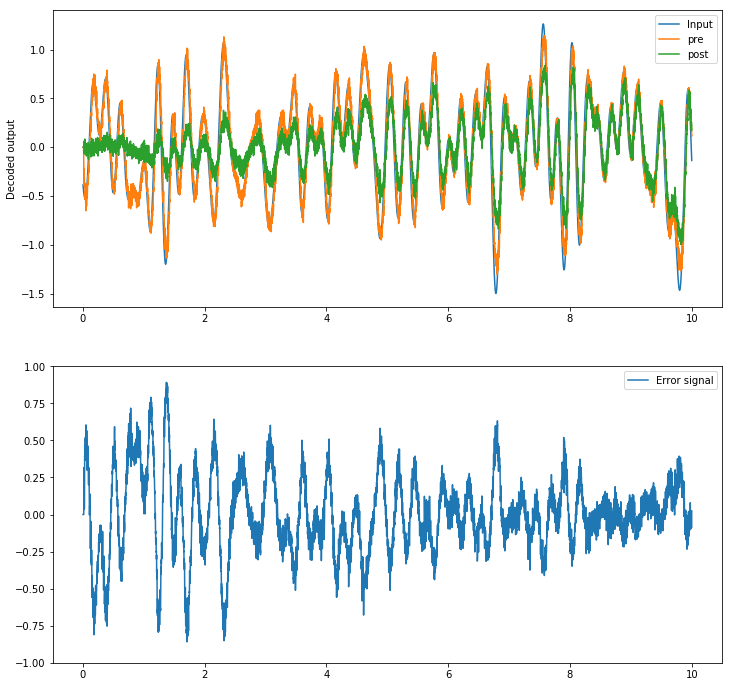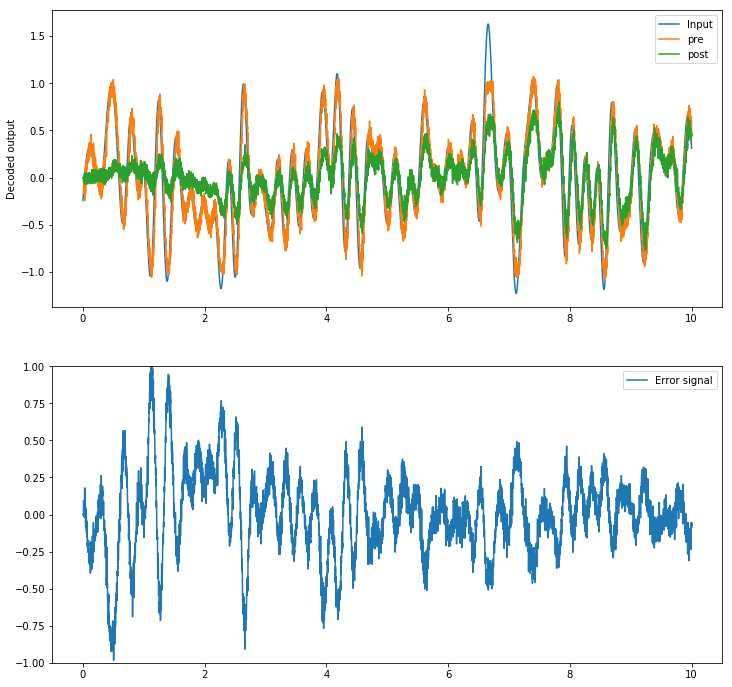In this example, we will use the PES learning rule to learn a communication channel.
[1]:
import matplotlib.pyplot as plt
%matplotlib inline
import nengo
from nengo.processes import WhiteSignal
import nengo_loihi
nengo_loihi.set_defaults()
/home/travis/build/nengo/nengo-loihi/nengo_loihi/version.py:23: UserWarning: This version of `nengo_loihi` has not been tested with your `nengo` version (3.0.0.dev0). The latest fully supported version is 2.8.0
nengo.__version__, latest_nengo_version))
/home/travis/virtualenv/python3.5.2/lib/python3.5/site-packages/nengo_dl/version.py:32: UserWarning: This version of `nengo_dl` has not been tested with your `nengo` version (3.0.0.dev0). The latest fully supported version is 2.8.0.
((nengo.version.version,) + latest_nengo_version))
WARNING: Logging before flag parsing goes to stderr.
W0624 00:12:55.114527 139838612113216 deprecation_wrapper.py:119] From /home/travis/virtualenv/python3.5.2/lib/python3.5/site-packages/nengo_dl/__init__.py:55: The name tf.logging.set_verbosity is deprecated. Please use tf.compat.v1.logging.set_verbosity instead.
W0624 00:12:55.115711 139838612113216 deprecation_wrapper.py:119] From /home/travis/virtualenv/python3.5.2/lib/python3.5/site-packages/nengo_dl/__init__.py:55: The name tf.logging.WARN is deprecated. Please use tf.compat.v1.logging.WARN instead.
When creating a nengo.Connection, you can specify a learning_rule_type. When using the nengo.PES learning rule type, the connection is modified such that it can accept input in its learning_rule attribute. That input is interpreted as an error signal that the PES rule attempts to minimize over time by adjusting decoders or connection weights.
[2]:
with nengo.Network(label="PES learning") as model:
# Randomly varying input signal
stim = nengo.Node(WhiteSignal(60, high=5), size_out=1)
# Connect pre to the input signal
pre = nengo.Ensemble(100, dimensions=1)
nengo.Connection(stim, pre)
post = nengo.Ensemble(100, dimensions=1)
# When connecting pre to post,
# create the connection such that initially it will
# always output 0. Usually this results in connection
# weights that are also all 0.
conn = nengo.Connection(pre, post,
function=lambda x: [0],
learning_rule_type=nengo.PES(learning_rate=2e-4))
# Calculate the error signal with another ensemble
error = nengo.Ensemble(100, dimensions=1)
# Error = actual - target = post - pre
nengo.Connection(post, error)
nengo.Connection(pre, error, transform=-1)
# Connect the error into the learning rule
nengo.Connection(error, conn.learning_rule)
stim_p = nengo.Probe(stim)
pre_p = nengo.Probe(pre, synapse=0.01)
post_p = nengo.Probe(post, synapse=0.01)
error_p = nengo.Probe(error, synapse=0.01)
We can use Nengo to see the desired model output.
[3]:
with nengo.Simulator(model) as sim:
sim.run(10)
t = sim.trange()
/home/travis/virtualenv/python3.5.2/lib/python3.5/site-packages/nengo/builder/optimizer.py:640: UserWarning: Skipping some optimization steps because SciPy is not installed. Installing SciPy may result in faster simulations.
warnings.warn("Skipping some optimization steps because SciPy is "
[4]:
def plot_decoded(t, data):
plt.figure(figsize=(12, 12))
plt.subplot(2, 1, 1)
plt.plot(t, data[stim_p].T[0], label='Input')
plt.plot(t, data[pre_p].T[0], label='pre')
plt.plot(t, data[post_p].T[0], label='post')
plt.ylabel("Decoded output")
plt.legend(loc='best')
plt.subplot(2, 1, 2)
plt.plot(t, data[error_p])
plt.ylim(-1, 1)
plt.legend(("Error signal",), loc='best')
plot_decoded(t, sim.data)

While post initially only represents 0, over time it comes to more closely track the value represented in pre. The error signal also decreases gradually over time as the decoded values in pre and post get closer and closer.
[5]:
with nengo_loihi.Simulator(model) as sim:
sim.run(10)
t = sim.trange()
[6]:
plot_decoded(t, sim.data)
